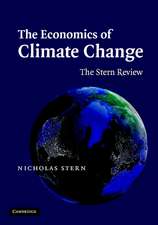Environmental Stress: Indication, Mitigation and Eco-conservation
Editat de Mohammad Yunus, Nandita Singh, L.J. de Koken Limba Engleză Paperback – dec 2010
Unlike other already existing works this volume elucidates the plant-pollutant relationship in a manner that defines not only the drastic effects of pollutants on plants but concomitantly highlights the hitherto less focused areas namely phytoindication, phytoremediation and stress tolerant bioaesthetic development, thus concentrating more on plant than pollutant. The book would help understand the magnitude of environmental stress in the coming years and may play a formative role in defining future research and policy areas along with providing impetus to development of newer eco-technologies.
The book shall interest both students and researchers of environmental sciences, ecology, forestry and related disciplines as well as persons and organisations engaged in environmental management and eco-conservation.
| Toate formatele și edițiile | Preț | Express |
|---|---|---|
| Paperback (1) | 953.35 lei 6-8 săpt. | |
| SPRINGER NETHERLANDS – dec 2010 | 953.35 lei 6-8 săpt. | |
| Hardback (1) | 959.82 lei 6-8 săpt. | |
| SPRINGER NETHERLANDS – 31 iul 2000 | 959.82 lei 6-8 săpt. |
Preț: 953.35 lei
Preț vechi: 1162.61 lei
-18% Nou
Puncte Express: 1430
Preț estimativ în valută:
182.42€ • 191.15$ • 150.81£
182.42€ • 191.15$ • 150.81£
Carte tipărită la comandă
Livrare economică 11-25 aprilie
Preluare comenzi: 021 569.72.76
Specificații
ISBN-13: 9789048155033
ISBN-10: 9048155037
Pagini: 488
Ilustrații: XVIII, 464 p.
Dimensiuni: 155 x 235 x 26 mm
Greutate: 0.67 kg
Ediția:Softcover reprint of hardcover 1st ed. 2000
Editura: SPRINGER NETHERLANDS
Colecția Springer
Locul publicării:Dordrecht, Netherlands
ISBN-10: 9048155037
Pagini: 488
Ilustrații: XVIII, 464 p.
Dimensiuni: 155 x 235 x 26 mm
Greutate: 0.67 kg
Ediția:Softcover reprint of hardcover 1st ed. 2000
Editura: SPRINGER NETHERLANDS
Colecția Springer
Locul publicării:Dordrecht, Netherlands
Public țintă
ResearchCuprins
Environmental Stress.- 1. Climate Change — Implications for the Developing Countries.- 2. Predicting the Impacts of Climate Change on Vegetation.- 3. Air Pollution Impacts on Agriculture — A Global Issue.- 4. Effects of Air Pollution on Herbivorous Insects.- 5. Floristic Summary of North American Plant Species in the Air Pollution Literature.- 6. The Impacts of Air Pollution on Crops in Developing Countries — A Case Study in Pakistan.- 7. Pollution vis-a-vis Biodiversity.- 8. Elevated Atmospheric Carbon Dioxide and Plant Responses.- 9. Implications for Variation in Carbon Sources for the Global Warming Potential of Methane.- 10. The Impact of Nitrogen Compounds — A Problem of Growing Concern.- 11. Nitrogen Dioxide and Nitrogen Nutrition in Plants.- 12. Atmospheric H2S Pollution — Deposition and Impact on Sulphur Metabolism in Plants.- 13. Long-Term Effects of Metal on Helophytes in Lakes.- 14. Heavy Metal Emission from Thermal Power Plants and its Implication on Vegetative Environment — A Case Study.- 15. Studies on the Impact of Certain Oxidizing Pollutants and Growth Regulating Substances on Oryza sativa var. Tulasi.- Stress Indication.- 16. Cadmium Induced Adaptive Response in Plant Cells In vivo — A Possible Model Based on Genotoxicity Studies.- 17. Screening for Clastogenic Effects of Arsenicals on Plants In vivo.- 18. Effect of Chromium (VI) on Growth and Physiology of Giant Duckweed Spirodela polyrrhiza (L.) Schleiden.- 19. Effects of Transpiration, Carbon Dioxide and Ozone on the Content of Cadmium and Zinc in Spring Wheat Grain.- 20. Growth Responses of Cassia sophera L. to Thermal Power Plant Emissions with Reference to Distance from the Source.- 21. Toxicity of Arsenic on Two Tropical Marine Phytoplankton.- 22. Aquatic Weeds as Indicators ofWater Quality.- 23. A Comparative Survey of the Phytoplanktonic Flora in the Three Lagoons in Southern Sri Lanka with Special Reference to Their Usage as Biomonitors.- 24. Evaluation of Plants Growing Around a Cement Factory.- 25. Wild Plant Species in Bioindication of Polluted Environment.- 26. Calcutta Metropolis — Pollution and Plants.- 27. Copper and Zinc Content in the Food Commodities of Hyderabad.- 28. Methane Efflux from Wetland Rice Fields.- 29. The Use of Plants to Measure Global Distribution of Organochlorines.- 30. Effects of Toxicants (pollutants) on a Biological Species — Some Mathematical Models.- Mitigation & Eco-conservation.- 31. Lead Mediated Synthesis of Metal Binding Peptides (Phytochelatins) in Aquatic Plant Vallisneria spiralis L.- 32. Biosynthesis and Metal-Binding Characteristics of Phytochelatins.- 33. Studies on Potential Use of Cyanobacterium Westiellopsis for Bioremediation of Copper.- 34. Use of Water Hyacinth (Eichhornia crassipes) in Treatment Systems for Textile Factory Effluents.- 35. Environmental Degradation and Ex-situ Conservation of Nelumbo nucifera.- 36. Embryological Base of Plasticity and Adaptive Potentials of Reproductive Systems in Flowering Plants.- 37. Ecotechnological Approach in Greenbelt Development.- 38. Greenbelts for Industrial Areas.- 39. Revegetation of a Coal Mine Overburden Dump.- 40. Reclamation of Flyash Landfill Areas Through Planting of Nitrogen Fixing Tree Species.- Acknowledgements.









